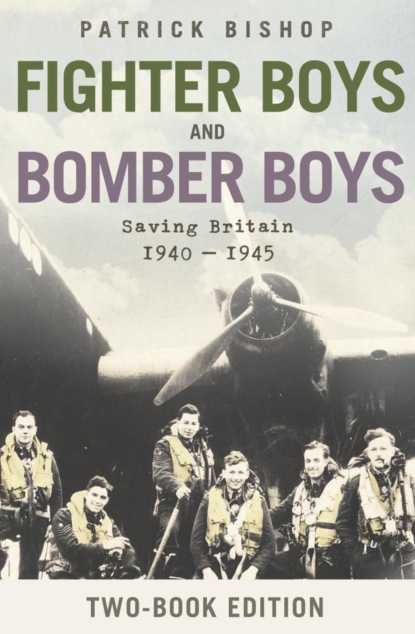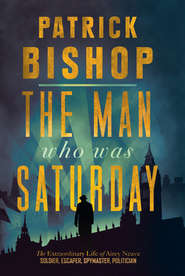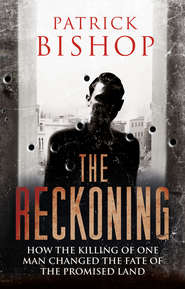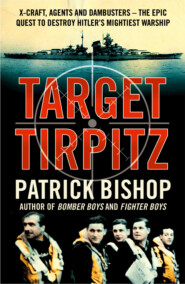По всем вопросам обращайтесь на: info@litportal.ru
(©) 2003-2024.
✖
Fighter Boys and Bomber Boys: Saving Britain 1940-1945
Настройки чтения
Размер шрифта
Высота строк
Поля
His biggest concern was ‘how deadly scared I’d been when I first saw those enemy bullets streaming past my wing-tip. I had never known any fear like that before in my life…I just fervently hoped I could keep it under control.’ Vigors met Bader on landing and gave a suitably stiff-upper-lip account of the engagement. But when he reached dispersal, where the returning 222 Squadron pilots were noisily and excitedly discussing the fight, and saw Hilary Edridge, his best friend in the squadron, neither of them hid their feelings.
‘Glad to see you in one piece,’ I exclaimed. ‘How did you do?’
‘Never been more scared in my whole bloody life,’ he laughed.
‘That makes two of us,’ I replied. ‘I was shit scared from the word go.’
The next day Vigors completed his baptism. On the second patrol of the day, 222 Squadron ran into a formation of Heinkels. He latched on to one, but his bullets drifted below it and before he could find another the Messerschmitts arrived. Vigors was chased and pulled sharp right as hard as he could, blacking out but bringing himself up behind the German and finding to his satisfaction that he was turning inside him. They were now on opposite sides of the circle in a classic dogfighting position. Vigors kept reefed tight into the turn, on the edge of unconsciousness because of the terrific G forces, until he almost had the target in his sights. In desperation the German dived for the sea, the tactic Vigors had used the previous day. But by now he was right on top of him and at 200 yards opened fire. ‘I saw my bullets ripping into his starboard wing and suddenly he burst into a ball of flame. “Got you, you bastard!” I yelled.’ This exultation vanished when he ‘felt a tug on my right wing and to my horror I saw holes appearing in the wing-tip’. A 109 darted beneath him and then the sky was clear again. A roll of the controls told him that the Spitfire would get him home.
Examining his feelings on the return journey, he was ‘more than happy to have made my first kill’ and felt the same satisfaction as when, on his family estate near Clonmel, he had ‘pulled down a high-flying pigeon flashing across the evening sky with the wind up his tail.’ There was a sombre moment at the thought he had just killed a man. He and his adversary would, he pondered, have ‘probably got on well together if we’d met drinking beer in a pub’. The mood did not last long. ‘But he was on the wrong side,’ he concluded. ‘He shouldn’t have signed up with that bastard Hitler.’ Later he was ‘surprised that he did not feel more remorse’. In the space of forty-eight hours, Tim Vigors had tasted many of the common experiences of flying a fighter in combat, short of being shot down, wounded or killed. Fifty hours of training was worth less than one hour of the real thing.
By early summer every squadron in Fighter Command except two had clashed with the Luftwaffe on at least one occasion. At this early stage, operations proceeded in an orderly fashion. Standing at dispersal in the rising light of dawn or the glare of an early summer afternoon, the squadron or flight was given its instructions on the ground by the commander. Then, as the riggers and fitters climbed down off the wings, the pilots hoisted themselves up by placing a right foot in the step set into the left side of the fuselage. They then put their other foot on the wing root and swung over into the narrow cockpit, stowing their parachute in the scooped recess of the steel bucket seat. Next came the nerve-calming routine of strapping in, switching on petrol, starting the engine and checking oxygen and instruments. On the order, they took off methodically and flew in formation until they reached the battle zone. The discipline of keeping position had the same effect as infantry drill, creating a feeling of security, a sense of strength in combination, that almost invariably evaporated as soon as the fighting began.
Everyone, at all times, constantly scoured the sky around them for aircraft. Good eyesight was a life-saver. Exceptional eyesight gave a pilot a considerable advantage, enabling him to see his victim before he himself was seen. Pilots twisted their heads up and down, left and right, continuously. In a regulation-wear collar and tie, necks were soon rubbed raw. It was for that reason that they began wearing the silk scarves which in time became their sartorial symbol.
On the outward journey the squadron, flight or section leader could talk to the other aircraft, and his voice and manner over the R/T was an important element in shaping the mood of the pilots behind him. Confident leaders gave confidence to those they led, and commanders could be forgiven many shortcomings if they had the gift of imparting reassurance. Some, like Deere, Kingcome and Bader, did so with a mixture of humour and profanity, using nicknames, reinforcing the ties of intimacy and affection that bound the best squadrons together. The possibility of giving encouragement and direction disappeared, however, in the explosion of confusion that followed engagement.
With the first sighting of Germans, the first ‘Tally ho!’, the low hum of anticipation jumped to a sharper pitch. Heads swivelled to the bearing as the pilots searched for the enemy aircraft. They went quickly into the last routine of preparation, dropping the seat to get maximum protection from the engine block in front and the armour plate behind, tightening straps, switching on the reflector sight, checking the range and wing-span indicators and flicking the gun button into the firing position. In the distance, the enemy aircraft seem always to have appeared as alien and malign objects, a different species. They looked like ‘flies’, ‘swarms of bees’, ‘a milling great mass of little insects’, never like birds, though flocks of birds could sometimes be mistaken for Germans by nervous pilots. Getting closer, the sight of the black crosses, edged in white, standing out on wings and fuselages, had a profound effect on pilots looking on them for the first time, striking them as sinister, redolent of death, bringing home with unexpected force the seriousness of what they were engaged in.
Once again, training helped to control feeling and instinct as the fighters responded to the designated attack order and manoeuvred into position. Paul Richey found that, on seeing the enemy, ‘all the tension and concentration in my body focused in a wild leap of my heart. It always made me swallow hard a couple of times.’ Then it was ‘into action, body taught against the straps, teeth clenched, thumb on the gun button, narrowed eyes intent on getting that black-crossed Hun in the sights and holding him there.’ He felt his ‘pounding heart turn into a block of ice. Not in fear. My brain became coldly clear and I was transformed into a cool, calculating killer.’
(#litres_trial_promo)
Shooting a smallish, nimble object travelling at more than 300 m.p.h., when you are moving at a similar speed while diving, turning and rolling, was extraordinarily hard. The difficulties were multiplied by the heavy G forces that crushed the pilots’ heads down on their chests, and turned the blood in their veins to the weight of molten metal. Pilots found that when they finally got within range and opened fire, the bullets did not fly with undeviating, linear cleanliness, but wobbled and wavered. It was no wonder that when they spoke of shooting at an enemy they talked of ‘giving it a squirt’. The process was more akin to aiming a hose than firing an arrow. The reflector sight, which replaced the old ring sight, projected a dot of red light on the angled underside of the windscreen. It was bracketed by a set of range bars which could be adjusted to the size of bombers or fighters. Kingcome found, ‘It was quite helpful in assessing distances, and the red dot simply indicated the line of flight of your bullets…if you lined it up on a static target and were also stationary, you scored a hit. What it regrettably did not tell you was where to aim at a moving target, or how much deflection to allow…Such judgements only came from experience combined with instinct.’
(#litres_trial_promo)
Вы ознакомились с фрагментом книги.
Приобретайте полный текст книги у нашего партнера:
Приобретайте полный текст книги у нашего партнера:











